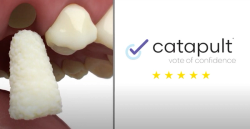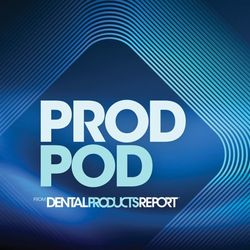- About Us
- Advertise
- Editorial
- Contact Us
- Terms and Conditions
- Privacy Policy
- Do Not Sell My Personal Information
© 2025 MJH Life Sciences™ and Dental Products Report. All rights reserved.
Where form and function meet
Over the years, I have seen many restorations being modified and compromised due to poor planning from the start. Developing a plan, turning it into a protocol and then following every step precisely, will ensure a predictable and successful restoration. For aesthetic anterior restorations it is most important to start with a diagnostic wax up. This is a solid foundation for any case. All the critical points such as: length, proportions and anatomical details will be determined.
Over the years, I have seen many restorations being modified and compromised due to poor planning from the start. Developing a plan, turning it into a protocol and then following every step precisely, will ensure a predictable and successful restoration.
For aesthetic anterior restorations it is most important to start with a diagnostic wax up. This is a solid foundation for any case. All the critical points such as: length, proportions and anatomical details will be determined.
No technician wants to make changes-such as adding to the incisal edge-when it’s time to deliver a case. We feel great pleasure when the case just drops in and we meet the patient’s expectations. To make this a standard rather than playing a lottery game, we need to follow a step-by-step approach.
First Step-the Wax Up: Find the right functional elements, the right size, proportions, and horizontal and vertical dimensions, which are parameters that can be determined in the wax up.
Occlusal concepts
For edentulous patients it has been common practice to set up denture teeth, because they are easy to place and quickly lead to a result. However, because those denture teeth are more generic rather than customized, it may lead to limits if the form or function needs to be modified. A more suitable solution, and equally as efficient, is the OccluMaster wax patterns by Aesthetic-Press. Because of their flexibility, these fully contoured posterior crowns help find the right occlusal dimensions in a very short time, while adjustments or functional elements can be easily done.
With the OccluMaster, a variety of occlusal concepts can be used and easily modified. The conventional P.K. Thomas anatomy can be found in our classic design, and the more advanced theories, like the Biomechanics taught by the renowned Michael Polz from Germany, can be found in the Premium morphology (Fig. A).
Creating the restoration
Milling a bar in zirconia offers a variety of advantages compared to its counterpart, metal. The very minimal porosity level of zirconia is far more biocompatible than any metal construction, not to mention the implications of soldering connections.
A passive fit of the bar is essential, which will be verified through a try in, in its frame stage. Any adjustments can be done chairside with light-cure materials. With a thorough milling procedure and controlled sintering process, the bar fits nicely to the implant.
01 The bar is designed and milling is started using a 16 mm zirconia block. Four different burs are used to mill the bar on a Zirkonzahn Eco milling machine (zirkonzahn.com). The abutment areas need to be milled very carefully.
02 Once the bar is almost finished, the housing for the screws is drilled into the zirconia before sintering. The Eco milling machine provides the ability to mill the housing for the lateral screws, especially for constructions like this complex restoration (Fig. B). In addition, the bar can be milled either parallel or at a 2 degree angle. This will ensure that the over structure will fit nicely, and the friction will keep both parts together. The set screws will lock the construction in its final position. The 4 lateral screws carry the metal housing, which will be inserted once sintering is completed.
03 After milling the bar, the color liquids are added and the bar is sintered while still connected to the block to retain the precise shape during the sintering process (Fig. C).
04 Cutting the connectors had to be done very carefully with water-cooling to avoid a fracturing of the bar. After fitting the bar, the zirconia was polished with the AP Diamond Polishing Paste, which has a high diamond content and gives the bar a perfect surface shine (Fig. D).
05 To cover the bar for the overstructure, the Rigid light-cure material was applied before the frame was put into the silicon matrix that was created from the original wax up (Fig. E).
06 Maintaining the occlusion is a very critical point when duplicating a precise wax up. AnaxDent’s AnaxForm (anaxdent.com) is a special mold maker ideal for transferring the wax up into resin. This mold maker also can be used for a wax injector to re-inject the previous wax up.
07 After milling the overstructure, the final details were milled after using the “drop the pin” technique. The milling bur is dropped approximately 0.75 mm, whereas the tester will stay in its original position (Fig. F). This technique will ensure the pressed porcelain has enough room for maximum stability and perfect light reflection (Fig. G).
08 Using the translucent Aesthetic-Press Zircon ingot will give you the optimum porcelain support. As Figure H illustrates, the Eco milling machine can be set to different angels to mill every corner of the restoration. After opening the set screws of the hinge, the milling plate can be adjusted as needed. The rotation of the 5 axes allows the placement of the lateral screws.
09 The Gingiva, as well as the tooth colors, are applied carefully with a brush before the sintering process. The color liquids are needed to support the final color with the right chroma from within. For the experts, slight color nuances can be applied with a micro brush. A variation from violet, gray as well as a mild orange can be applied to bring some life into the zirconia structure (Fig. I).
10 The pink porcelain will be pressed first. To accomplish this, the original wax up is re-injected onto the framework. The AP injection wax, with its specific properties, allows the occlusion and crowns to be removed with a simple cut of a scalpel at the red/white junction allowing the wax to be peeled off.
11 The length of the sprues for pressing this porcelain were significantly longer than allowed in any textbook. For a successful press result, the restoration was supported by 4 sprues on the inside and 5 on the outside of this full arch zirconia framework (Figs. J, K).
12 After investing the bridge for 15 minutes, bench set time was used before placing the ring into a cold burnout furnace. The program was set with a rising temperature of 17 degrees Celsius per minute. After reaching the final temperature of 850 degrees Celsius, a holding time of 60 minutes needs to be completed before placing the ring into the press furnace.
13 The AP Feldspar ingots should not be preheated. Using 6 x 2.5 g ingots, the length of the plunger had to be shortened by 50% for the oven to close. The gingiva part was pressed with the Aesthetic-Press gingiva ingots. The press time was 20 minutes and the distance travelled was 21 mm. The press time describes the time used for the plunger to move the porcelain into the form.
Working with such a large amount of zirconia requires a lot of attention to a very slow rising temperature and cooling time. An extended cooling time was needed before carefully de-vesting this massive zirconia overstructure. After checking the fit of the upper construction with the model, the wax injection completed the missing layer of the clinical crown.
14 Little adjustments were needed before the construction is ready to be re-invested for the second press cycle to press the white porcelain. Each tooth was connected with one sprue of gage 8 (Fig. L). The reconstruction should be centered as much as possible to keep a balance of the porcelain during the cooling phase. This proves the point, that with the AP ingots, structures of any kind and size can be successfully pressed. The press temperature and thickness are the keys to success.
15 With a precise wax up, only minimal corrections are needed to complete and glaze the construction (Fig. M). The ability to finalize the occlusion in wax makes such a large and complex case much easier to plan and manufacture. All the functional elements can be designed at the right place, more easily and more precisely than with a conventional build up technique in porcelain (Figs. N, O).
Conclusion
At the time when I developed the Aesthetic-Press System, I was looking for a system, which would help every technician simplify their work and make it more predictable at the same time (Fig. P). Working in my laboratory with my clients and technicians enabled me to develop this proven system and make it a success on a daily basis. This system is a great opportunity for every technician to bring high-end quality at an affordable price to their laboratory and even more importantly to make your work consistent for you and your technicians case by case.
About the author
After receiving his masters degree in 1993, Jörg Müller opened his dental laboratory in Düsseldorf, Germany. In 1999 he moved to San Francisco where he opened his second dental laboratory, European Dental, and developed the Aesthetic-Press System. Aesthetic-Press was founded in 2006 and now sells the AP System to many countries around the world. Müller is teaching technicians how to apply a proven system to streamline production and add a higher standard to their quality. The company’s motto is “Efficiency Through Simplicity.” Aesthetic-Press is not only selling a porcelain, but a completely integrated system that is unique in all its features. Aesthetic-Press has created a standard that ensures a reproducible and consistent high-end result, producing crowns and bridges that are amazingly beautiful.



